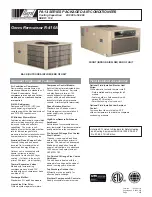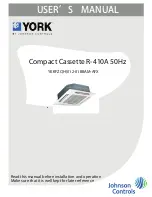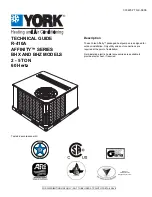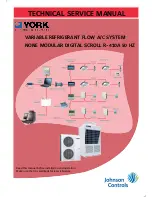
condensing unit is mounted/integrated, must
be in accordance with the PED.
• Beware of hot and extremely cold components.
• Beware of moving components. Power supply
should be disconnected while servicing.
9 – Filling the system
• Wear protective stuff like goggles and protective
gloves.
• Never start the compressor under vacuum. Keep
the compressor switched off.
• Before charging the refrigerant, verify that the oil
level is between ¼ and ¾ on the compressor oil
sight glass. If additional oil is required please refer
to the compressors label for type of oil.
• Use only the refrigerant for which the unit is
designed for.
•
Fill the refrigerant in liquid phase into the
condenser or liquid receiver. Ensure a slow
charging of the system to 4 – 5 bar for R404A /
R507, R22, R452A or R448A/R449A and approx. 2
bar for R134a and R513A.
• Do not put liquid refrigerant through suction line.
• It is not allowed to mix additives with the oil
and/or refrigerant
•
The remaining charge is done until the
installation has reached a level of stable nominal
condition during operation.
• Never leave the filling cylinder connected to the
circuit.
10 – Verification before commissioning
Use safety devices in compliance with both
generally and locally applicable regulations and
safety standards.
• Verify that all electrical connections are properly
fastened and in compliance with local regulations.
• When a crankcase heater is required, it must be
energized at least 12 hours before initial start-up
and start-up after prolonged shut-down period.
11 – Start-up
• Never start the unit when no refrigerant is
charged.
• All service valves must be in the open position.
See picture 3.
• Check compliance between unit and power
supply.
• Check that the crankcase heater is working.
• Check that the fan can rotate freely.
•
Check that the protection sheet has been
removed from the backside of condenser.
• Balance the High Pressure / Low Pressure.
• Energize the unit. It must start promptly. If
the compressor does not start, check wiring
conformity, voltage on terminals and sequence
phase.
•
Eventual reverse rotation of a 3-phase
compressor can be detected by following
phenomena; unit doesn’t start, the compressor
doesn’t build up pressure, it has abnormally
high sound level and abnormally low power
consumption. In such case, shut down the unit
immediately and connect the phases to their
proper terminals.
•
If the rotation direction is correct the low
pressure indication on the low pressure gauge
shall show a declining pressure and the high
pressure indication on the high pressure gauge
shall show an increasing pressure.
12 – Check with running unit
• Check the fan rotation direction. Air must flow
from the condenser towards the fan.
• Check current draw and voltage.
•
Check suction superheat to reduce risk of
slugging.
• When a sight glass is provided observe the oil
level at start and during operation to confirm
that the oil level remains visible.
• Respect the operating limits.
•
Check all tubes for abnormal vibration.
Movements in excess of 1.5 mm require
corrective measures such as tube brackets.
•
When needed, additional refrigerant in liquid
phase may be added in the low-pressure side
as far away as possible from the compressor.
The compressor must be operating during this
process.
• Do not overcharge the system.
• Never release refrigerant to atmosphere.
• Before leaving the installation site, carry out
a general installation inspection regarding
cleanliness, noise and leak detection.
• Record type and amount of refrigerant charge
as well as operating conditions as a reference for
future inspections.
13 – Maintenance
Always switch off the unit at main switch
before remove fan panel.
Internal pressure and surface temperature are
dangerous and may cause permanent injury.
Maintenance operators and installers require
appropriate skills and tools. Tubing temperature
may exceed 100°C and can cause severe burns.
Ensure that periodic service inspections to
ensure system reliability and as required by local
regulations are performed.
To prevent system related problems, following
Periodic maintenance is recommended:
• Verify that safety devices are operational and
properly set.
• Ensure that the system is leak tight.
• Check the compressor current draw.
• Confirm that the system is operating in a way
consistent with previous maintenance records
and ambient conditions.
• Check that all electrical connections are still
adequately fastened.
• Keep the unit clean and verify the absence of
rust and oxidation on the unit components,
tubes and electrical connections.
The condenser must be checked at least once
a year for clogging and be cleaned if deemed
necessary. Access to the internal side of the
condenser takes place through the fan panel.
Microchannel coils tend to accumulate dirt on
the surface rather than inside, which makes them
easier to clean than fin-&-tube coils.
• Switch off the unit at main switch before remove
any panel from the condensing unit.
• Remove surface dirt, leaves, fibres, etc. with
a vacuum cleaner, equipped with a brush or
other soft attachment. Alternatively, blow
compressed air through the coil from the inside
out, and brush with a soft bristle. Do not use a
wire brush. Do not impact or scrape the coil with
the vacuum tube or air nozzle.
If the refrigerant system has been opened, the
system has to be flushed with dry air or nitrogen
to remove moisture and a new filter drier has to
be installed. If evacuation of refrigerant has to
be done, it shall be done in such a way that no
refrigerant can escape to the environment.
14 - Warranty
Always transmit the model number and serial
number with any claim filed regarding this product.
The product warranty may be void in following
cases:
• Absence of nameplate.
•
External modifications; in particular, drilling,
welding, broken feet and shock marks.
• Compressor opened or returned unsealed.
• Rust, water or leak detection dye inside the
compressor.
• Use of a refrigerant or lubricant not approved by
Danfoss.
• Any deviation from recommended instructions
pertaining to installation, application or
maintenance.
• Use in mobile applications.
• Use in explosive atmospheric environment.
• No model number or serial number transmitted
with the warranty claim.
15 – Disposal
Danfoss recommends that condensing
units and oil should be recycled by a
suitable company at its site.
16 - Fan speed controller setting for R134a/R513A refrigerant
FSC type
Fan speed Controller
Spare part number
Refrigerant
letter
For Refrigerant
Factory
setting
Action required
XGE-4C
061H3140
Q
R404A/R452A/R507
19 bar
360°=1 turn = Approx 1.5 bar
(Clockwise rotation =
Increase pressure setting,
Counter clockwise rotation =
Decrease pressure setting)
V
R404A/R507/R448A/R449A/R452A
If refrigerant used is R134a or R513A
Turn the adjusting screw towards counter-
clockwise (-) by 6 turns to set the pressure
from 19 bar to 10 bar.
Controller will be damaged if this warning is not followed
When Fan speed Controller is at factory setting (19 bar):
- Maximum number of turns allowed in clockwise direction (+) = 4.
- Maximum number of turns allowed in anti-clockwise direction (-) = 6
Instructions
118A0665C - AN238286441930en-001401 | 3
© Danfoss | DCS (CC) | 2020.06






























